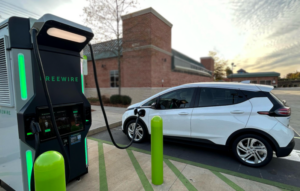Energy storage has grown significantly over the last ten years, particularly because of the Tesla Powerwall, Powerpack, and Megapack battery systems, the latter being for commercial applications. There is another viable commercial option, though it receives less attention: thermal energy storage. The Beverly Hilton and The Waldorf Astoria Beverly Hills hotels recently announced the launching of their new ice-based thermal energy storage system from Nostromo Energy. Nostromo installed a 1.4 megawatt-hour energy storage system to serve both hotels, which are known for being the most or among the most prestigious in Beverly Hills, CA. (The Beverly Hilton has hosted the annual Golden Globe awards for decades, for example.)
Nostromo Energy’s CEO, Yoram Ashery, provided many details about the system for CleanTechnica.
What technology does your ice-based thermal energy storage system use?
Nostromo developed the IceBrick technology, which is the first compact and modular cold-energy storage cells designed for retrofitting existing buildings with a central-chilled water system, or about 25% of the US commercial built space. The water-based cells include proprietary ingredients and use advanced thermodynamics to deliver unmatched performance, 90% round-trip-efficiency, and high flexibility to answer a wide range of energy requirements.
How does the system work?
Air conditioning accounts for about half of the energy use in buildings. Supplying these massive loads from a storage system enables buildings to become huge, clean batteries for balancing the grid (by flexing the demand) and integrating more renewables.
Buildings, which consume 75% of all electricity, can enable the grid to integrate more renewables by shifting their consumption from hours of fossil-generated power to hours of renewables-generated power. To shift consumption — without changing operation — buildings must have energy storage. According to a study by LBNL (Lawrence Berkeley National Lab), commercial air conditioning is the biggest opportunity for shifting loads on the grid, representing almost the full potential by the commercial sector and a third on the grid overall.
The IceBrick storage system charges by freezing the water-based cells using clean energy during off-peak (low cost) hours. When renewable sources are out (like at sunset), the system discharges the energy into the building’s central air conditioning system supplying the same cold energy it needs but without using electricity from the grid. This way, the building not only enjoys carbon-free-energy all day for air conditioning, its biggest energy use, but it also significantly cuts down its energy costs, by avoiding peak pricing or participating in the demand response market.
The demand response market also provides resilience to the grid, helping reduce loads and divert blackouts during surge in demands, thereby protecting the community from outage.
About how much time is required to install it and make it operational?
The IceBrick system can be up and running approximately 6 to 9 months from contracting.
Once it is installed, who manages it, and how is it managed?
The IceBrick system is fully automated. It is managed by a cloud-based software that collects dozens of data streams, from the building and external, analyzing them in real-time using algorithms and machine learning to generate individually customized operational plans for each system, which are transmitted to an on-site programmable controller that operates the compressors, pumps and valves for charging and discharging the systems at the optimal times. The cloud-based management system constantly monitors and optimizes the IceBrick system’s operation and reports its carbon emissions avoidance, cost savings and other data in realtime on dashboards accessible from every device.
What is the storage capacity for a typical system?
It is customized to the building needs, to be able to supply its cooling loads for 4-5 hours. Typically building sizes are 100,000 sq ft and larger. Capacity expressed in cooling energy units is thousands of Ton-refrigeration hours, and in electrical units it is Megawatt-hours. For most buildings systems will be in the 1-3 MWh range.
What is the typical cost of the system, including installation?
A rough-order-of-magnitude is $1M for 1 MWh capacity, of a turnkey installation, fully-commissioned system, before incentives. It can be more or less depending on the installation conditions, existing cooling systems, a new construction or retrofit. A purchasing customer in California will average 5 years payback and enjoy the system for 25 years or more. The system is eligible for investment tax credit (ITC) and local utility rebates, which effectively lowers capital acquisition cost by about a half, and there are multiple financing options, like leasing or clean-energy loans.
Buildings can also enjoy the system as a service, with zero down payment of capital costs. Under the service options, Nostromo arranges financing and sells energy to the customer at a guaranteed discount to its utility costs. Service customers can lower their energy bills, carbon emissions and enhance energy resilience, without investing anything.
What is the system’s warranty duration, and how long will the system last?
The system has been designed and test-proven to operate at least 20-25 years with only 1% degradation in capacity. Nostromo provides a 10-year warranty on the IceBrick storage units, which can be extended to up to 20 years under service agreement.
About how much will each hotel save per year by reducing their electricity consumption, and how much will they reduce their carbon emissions?
An IceBrick system can save 30-50% of the cooling costs for a typical hotel in California under a capital ownership model, or more than 10% under the service model, and save about 200 metric tons of CO2 annually (regardless of the model).
Does your system have the capability to provide backup power during outages?
The IceBrick system’s output is cold (thermal) energy, which can be used to power the facility’s cooling (HVAC) system, which will only need 5% of its usual electrical load for circulation. Cooling is a mission-critical function for facilities such as for data centers, hospitals or clean rooms, and also very important for hotels, as blackouts are more prone during summer and high season. Due to its high energy consumption, air conditioning cannot be powered during outages using standard batteries (only diesel generators), but with an IceBrick system supplying the cold energy, which consumes 95% of electricity, batteries can provide the remaining 5% to continue air conditioning operation. Since the IceBricks do not discharge electricity, it cannot power electrical appliances during outages, but by reducing the loads and participating in demand response programs it can mitigate the risk of outages during grid congestion.
Your IceBrick® cells do not contain any toxic or flammable materials, so what are they made of?
The IceBrick is made of standard metals and plastic.
Sign up for daily news updates from CleanTechnica on email. Or follow us on Google News!
Have a tip for CleanTechnica, want to advertise, or want to suggest a guest for our CleanTech Talk podcast? Contact us here.
Former Tesla Battery Expert Leading Lyten Into New Lithium-Sulfur Battery Era — Podcast:
I don’t like paywalls. You don’t like paywalls. Who likes paywalls? Here at CleanTechnica, we implemented a limited paywall for a while, but it always felt wrong — and it was always tough to decide what we should put behind there. In theory, your most exclusive and best content goes behind a paywall. But then fewer people read it! We just don’t like paywalls, and so we’ve decided to ditch ours. Unfortunately, the media business is still a tough, cut-throat business with tiny margins. It’s a never-ending Olympic challenge to stay above water or even perhaps — gasp — grow. So …
Advertisement
- SEO Powered Content & PR Distribution. Get Amplified Today.
- EVM Finance. Unified Interface for Decentralized Finance. Access Here.
- Quantum Media Group. IR/PR Amplified. Access Here.
- PlatoAiStream. Web3 Data Intelligence. Knowledge Amplified. Access Here.
- Source: https://cleantechnica.com/2023/06/12/beverly-hilton-waldorf-astoria-beverly-hills-announce-new-thermal-energy-storage-system/
- :has
- :is
- :not
- $UP
- 000
- 1
- 100
- 13
- 20
- 20 years
- 200
- 25
- 9
- 95%
- a
- Able
- About
- above
- accessible
- According
- Accounts
- acquisition
- advanced
- Advertise
- Agreement
- AIR
- Air Conditioning
- algorithms
- All
- also
- always
- among
- an
- analyzing
- and
- Announce
- announced
- annual
- Annually
- Another
- answer
- any
- anything
- appliances
- applications
- approximately
- ARE
- AS
- At
- attention
- Automated
- average
- avoiding
- awards
- Backup
- backup power
- balancing
- batteries
- battery
- battery systems
- BE
- because
- become
- been
- before
- behind
- being
- Berkeley
- BEST
- Biggest
- Bills
- Bit
- both
- Building
- built
- business
- but
- by
- CA
- california
- CAN
- cannot
- Capacity
- capital
- carbon
- carbon emissions
- Cells
- Centers
- central
- ceo
- challenge
- changing
- charges
- charging
- chip
- Circulation
- clean energy
- cleantech
- Cleantech Talk
- co2
- cold
- collects
- commercial
- community
- conditions
- congestion
- constantly
- construction
- consume
- consumption
- content
- continue
- contracting
- controller
- Cost
- cost savings
- Costs
- credit
- customer
- Customers
- customized
- cuts
- dashboards
- data
- data centers
- day
- decades
- decide
- decided
- deliver
- Demand
- demand response
- demands
- Depending
- designed
- details
- developed
- device
- diesel
- Discount
- do
- does
- don
- down
- dozens
- due
- duration
- during
- each
- effectively
- electricity
- electricity consumption
- eligible
- Emissions
- enable
- enables
- energy
- Energy Consumption
- energy use
- enhance
- enjoy
- Era
- Even
- Every
- example
- Exclusive
- existing
- expert
- expressed
- external
- facilities
- fewer
- financing
- First
- Flexibility
- For
- Freezing
- from
- FT
- full
- fully
- function
- generate
- generators
- globe
- Goes
- Golden
- Grid
- Grow
- grown
- guaranteed
- Guest
- Half
- Have
- help
- helping
- here
- High
- Hills
- Hilton
- hospitals
- hosted
- hotel
- hotels
- HOURS
- How
- http
- HTTPS
- huge
- hvac
- if
- implemented
- important
- in
- Incentives
- include
- Including
- Individually
- install
- installation
- integrate
- Integrating
- into
- investing
- investment
- iPhone
- IT
- ITS
- jpg
- just
- known
- lab
- larger
- Last
- launching
- leading
- learning
- leasing
- least
- less
- like
- Limited
- load
- loads
- Loans
- local
- Long
- Low
- lower
- machine
- machine learning
- made
- make
- managed
- management
- management system
- manages
- many
- margins
- Market
- massive
- materials
- max-width
- Media
- Metals
- metric
- Mitigate
- model
- modular
- monitors
- monthly
- months
- more
- most
- much
- multiple
- must
- National
- Need
- needs
- New
- New Construction
- news
- of
- Olympic
- on
- only
- operate
- operates
- operation
- operational
- Opportunity
- optimal
- Optimizes
- Option
- Options
- or
- Other
- our
- out
- outage
- Outages
- output
- over
- overall
- ownership
- participating
- particularly
- Patreon
- PAYBACK
- payment
- PayPal
- Peak
- People
- performance
- perhaps
- plans
- plastic
- plato
- Plato Data Intelligence
- PlatoData
- please
- podcast
- potential
- power
- powered
- prestigious
- pricing
- Programs
- proprietary
- protecting
- provide
- provided
- provides
- pumps
- purchasing
- put
- range
- Read
- real-time
- realtime
- receives
- recently
- reduce
- reducing
- Regardless
- remaining
- Renewable
- Renewables
- Reports
- representing
- required
- Requirements
- resilience
- response
- Risk
- Rooms
- running
- s
- same
- Save
- Savings
- Season
- sector
- Sells
- serve
- service
- shift
- SHIFTING
- should
- significantly
- since
- sizes
- So
- Software
- Sources
- Space
- SQ
- standard
- stay
- Still
- storage
- streams
- Study
- such
- suggest
- summer
- Sunset
- supply
- supplying
- support
- surge
- system
- Systems
- Talk
- tax
- tax credit
- team
- Technology
- ten
- Tesla
- than
- that
- The
- their
- Them
- then
- theory
- There.
- thereby
- thermal
- These
- they
- Third
- this
- though?
- thousands
- time
- times
- tip
- to
- tons
- tough
- typical
- typically
- under
- units
- unmatched
- Updates
- us
- use
- used
- using
- utility
- valves
- Ve
- very
- via
- viable
- want
- was
- Water
- Way..
- we
- What
- when
- which
- while
- WHO
- wide
- Wide range
- will
- with
- without
- Work
- Wrong
- year
- years
- you
- Your
- zephyrnet
- zero












